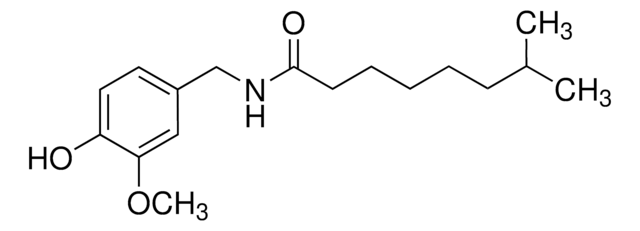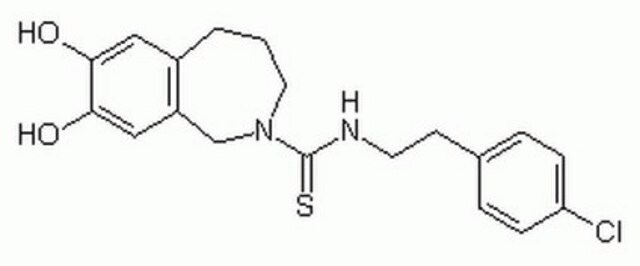M2028
Capsaicin
from Capsicum sp., ≥95% (HPLC), powder, TRPV1 agonist
Synonyme(s) :
8-Methyl-N-vanillyl-trans-6-nonenamide
About This Item
Produits recommandés
product name
Capsaicin, ≥95%, from Capsicum sp.
Source biologique
Capsicum sp.
Pureté
≥95%
Pf
62-65 °C (lit.)
Solubilité
H2O: insoluble
ethanol: soluble
Température de stockage
2-8°C
Chaîne SMILES
COc1cc(CNC(=O)CCCC\C=C\C(C)C)ccc1O
InChI
1S/C18H27NO3/c1-14(2)8-6-4-5-7-9-18(21)19-13-15-10-11-16(20)17(12-15)22-3/h6,8,10-12,14,20H,4-5,7,9,13H2,1-3H3,(H,19,21)/b8-6+
Clé InChI
YKPUWZUDDOIDPM-SOFGYWHQSA-N
Informations sur le gène
human ... CYP1A2(1544) , TRPV1(7442)
rat ... Trpv1(83810) , Trpv4(66026)
Vous recherchez des produits similaires ? Visite Guide de comparaison des produits
Description générale
Application
- to study its effects on chromatin remodeling and gene expression related to synaptic plasticity
- to study TRPV1 channel signaling in H2C1 cells (which are human embryonic kidney 293 cells expressing TRPV1 channels)
Actions biochimiques/physiologiques
Mention d'avertissement
Danger
Mentions de danger
Conseils de prudence
Classification des risques
Acute Tox. 2 Oral - Eye Dam. 1 - Resp. Sens. 1 - Skin Irrit. 2 - Skin Sens. 1 - STOT SE 3
Organes cibles
Respiratory system
Code de la classe de stockage
6.1A - Combustible acute toxic Cat. 1 and 2 / very toxic hazardous materials
Classe de danger pour l'eau (WGK)
WGK 3
Point d'éclair (°F)
235.4 °F - closed cup
Point d'éclair (°C)
113 °C - closed cup
Équipement de protection individuelle
Eyeshields, Faceshields, Gloves, type P2 (EN 143) respirator cartridges
Certificats d'analyse (COA)
Recherchez un Certificats d'analyse (COA) en saisissant le numéro de lot du produit. Les numéros de lot figurent sur l'étiquette du produit après les mots "Lot" ou "Batch".
Déjà en possession de ce produit ?
Retrouvez la documentation relative aux produits que vous avez récemment achetés dans la Bibliothèque de documents.
Les clients ont également consulté
Notre équipe de scientifiques dispose d'une expérience dans tous les secteurs de la recherche, notamment en sciences de la vie, science des matériaux, synthèse chimique, chromatographie, analyse et dans de nombreux autres domaines..
Contacter notre Service technique












